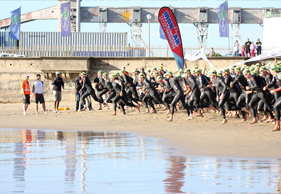If you are one of the nearly 3 000 athletes who have entered Spec-Savers Ironman 70.3 South Africa, count yourself as fortunate, because not only have you secured a sought after spot, you will also be part of the biggest Ironman 70.3 event in the world! But before you can line up on Orient Beach on 22 January, there are still just a little under eight weeks of hard training to negotiate. Now is the time to stay positive and most of all believe in yourself, just as our 10 DARE TO TRI team members are doing in their quest to conquer one of the greatest triathlon events on our sporting calendar.
Download the training programme for December and January here.
World Endurance South Africa (WESA), the Spec-Savers Ironman 70.3 South Africa, Spec-Savers Ironman South Africa and affiliates do not endorse nor promote this training programme in any way. This programme is not an officially endorsed Spec-Savers Ironman 70.3 South Africa or Spec-Savers Ironman South Africa training programme and has been independently created by Modern Athlete. WESA assumes no risks or liability for any injuries, loss or harm caused by following this programme.
OVERCOMING FEARS
The Modern Athlete DARE TO TRI swimming workshop was recently held at St. Benedict’s High School in Bedfordview, and Georgie Thomas, operator and owner of Total Immersion Swimming South Africa, flew up from Port Elizabeth to share her knowledge and experience with our team members and guests.
From the workshop it was clear that most novice triathletes fear the swimming leg of a triathlon and from the practical session it was even clearer that everyone was very eager to learn to swim with the correct technique. Georgie put the more than 70 athletes through their paces in the pool and afterwards everyone agreed that learning to swim with the correct technique is the only way to becoming a better triathlete. It sure is no fun to struggle ‘efficiently.’
Our 10 DARE TO TRI team members not only attended the workshop, but also stayed on for an additional two-day workshop hosted by Georgie. A ‘before and after’ video was taken of each team member, and by day two it was absolutely remarkable to see how each team member had improved and how each one had overcome their fear of swimming and become confident in the water. The team members’ reaction after the workshop ranged from ‘an amazing experience’ and ‘a lifetime opportunity’ to ‘this is something that every triathlete should do.’
STICKING WITH THE PROGRAMME
The most important thing you can do right now is to believe in your training programme, the hard work you have done up to now, and most importantly, stay consistent. We will now aim to increase our weekly sessions slowly, but remember, if you are not able to increase the number of sessions, try to keep a constant two sessions for each sport. Always follow the important guideline: TRAIN, DON’T STRAIN! Finish every training session with something in reserve, and listen to your body and rest when necessary.
PHASE 2 TRAINING PLAN
Having done a few weeks of two sessions per week of each sport, the plan is to build up to three per week, with a minimum of two. Add one session per week until you get up to nine and hold that for two weeks. Then go back to six and build up again. The basic training for each sport will be as follows:
RUNNING: We will build this to 20km at an easy and relaxed pace. One quality session per week, consisting of a hill repeat or a tempo run, will be introduced.
BIKE: We will build this to 90km at a relaxed pace. Spin at a high cadence at around 90 revolutions per minute. We will introduce some hill work, either repeats or a ride over a hilly course during the midweek shorter ride.
SWIMMING: We will now take this up to 2km. Remember, an open water swim per week is essential. Always swim in open water with other triathletes and use these sessions to practise ‘sighting’ the swim buys. Pool sessions should focus on good technique.
BRICK SESSIONS: Swimming to bricks are best done at the gym: Swim a continuous 1km at a good pace and immediately ride a stationary bike for 30 minutes. Biking to run bricks are much harder. The aim is to run a few kilometres after a long bike and a shorter midweek bike. Start at 3km and work up to a maximum of 8km. These sessions are difficult, as the muscles you use for cycling and running are very different. Work on your running form and cadence and try to do these runs at the pace you would expect to run in the 70.3, which will be significantly slower than your usual 21km times.
TRIATHLON RACES
It is important to experience a triathlon race as part of your preparation, because training is no substitute for doing a race to experience swimming in a large group, transitions, pacing your ride and then running on tired legs! Visit www.triathlonsa.co.za and check out the events calendar to find shorter races that you can do to build up to the 70.3.
Next month we will bring you some final race day tips and advice to make your journey memorable and your dream a reality. So look out for the January Edition of Modern Athlete, which will be available from 15 January.


